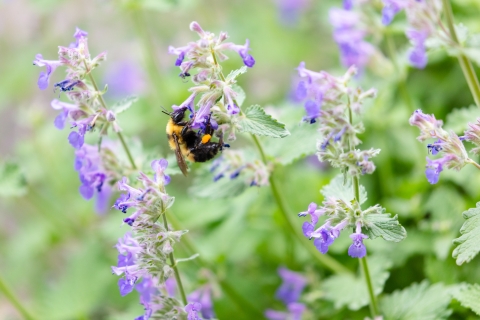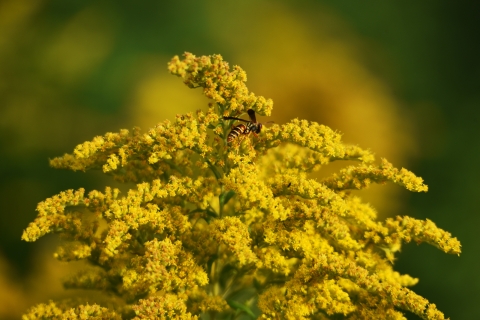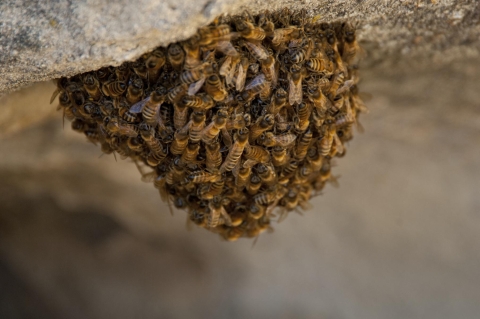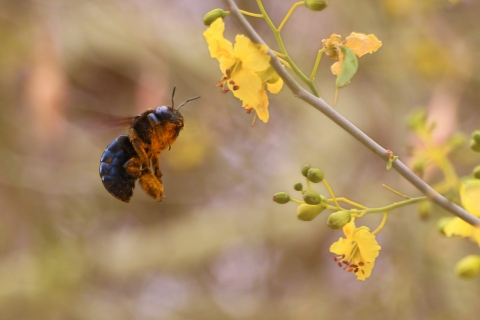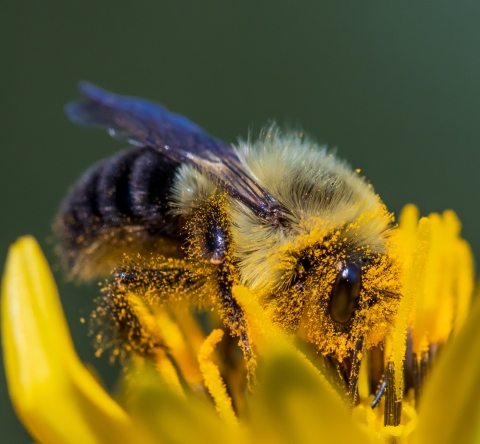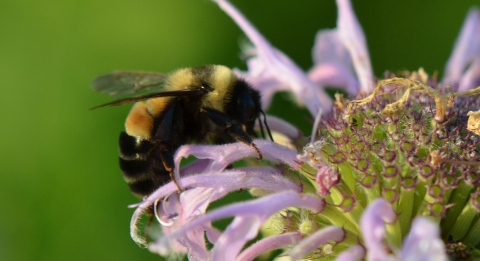Are daisies as delectable as dandelions? Do coneflowers satisfy cravings like lilacs? The U.S. Geological Survey (USGS) and the U.S. Fish and Wildlife Service’s (Service) Native Bee Lab are polling the pollinators in their newly developed “Ask a Bumble Bee Survey.” This effort will harness the power of the public to determine once and for all what plants bees prefer.
Unlike previous studies that focused on small areas, this comprehensive survey will collect data from across the Northeast, in a variety of terrains, from rural landscapes to urban environments.
“The most fun part of this survey is there are no specific locations,” said USGS Bumble Bee Citizen Science Survey Coordinator Jenan El-Hifnawi. “You really can pick wherever you want to walk and enjoy the day.”
Most importantly, it’s open to everyone! All you need is a smart phone, pencil, paper, green space to explore, and an enthusiasm for bees.
The effort will focus on carpenter bees and bumble bees, so before you start surveying for them, it helps to get to know all of the bees -- and wanna-bees -- you are likely to meet in your neighborhood.
Bogus Bees
Wasps – including the yellow jacket, European hornet, and paper wasp -- are commonly confused for bees. Although they are genetically related, these winged warriors belong to a whole different family. Even from a safe distance, you can identify wasps a by their smooth, slender bodies. Although they may look dainty, wasps are workaholics and are essential pollinators for crops like macadamia nuts, mangos, and sesame. They also control agricultural pests by munching on nuisance flies and caterpillars.
What do these wasps have in common? Besides being pest control pros, these wannaBEEs will typically sting only if the offender is within a few feet of their hive.
Solitary bees
Introverts can identify with solitary bees. These bees vary in size but are generally smaller than bumble bees. As independent icons, solitary bees won’t swarm, make honey or wax, or serve a queen. Some solitary bees may nest in large groups, but like a disgruntled detective, they work alone.
Contrary to popular belief, these bees are incredible pollinators and outperform superstars like the honeybee. Looking for these lonesome outliers? Most solitary bees are miners. They build their nest by tunneling into sand, clay, soil, mortar, and wood. The males cannot sting but the females will do so only when stepped on, swatted or threatened. Solitary bees are largely harmless and typically won’t attack even if their nests are threatened. Talk about chill vibes.
Honeybees
These famous sweet bees have brought us big hits like honey and mead. According to the U.S. Food and Drug Administration, they pollinate nearly one-third of the foods eaten by Americans, including apples, melons, cranberries, pumpkins, squash, broccoli, and almonds. The absolute icons of the bee world, honeybees form the typical social structure structure
Something temporarily or permanently constructed, built, or placed; and constructed of natural or manufactured parts including, but not limited to, a building, shed, cabin, porch, bridge, walkway, stair steps, sign, landing, platform, dock, rack, fence, telecommunication device, antennae, fish cleaning table, satellite dish/mount, or well head.
Learn more about structure seen in movies, with a queen, male drones to tend the hive, and female worker bees.
Honeybees are especially important for pollination in colder months, foraging when other bees are inactive. When female worker bees are away from the hive, they rarely sting. Their barbed stingers are attached to their lower abdomen. This means the honeybee can sting only once and then it’s cheerio.
Carpenter bees
One of the focal bees for this pollinator survey, carpenter bees are often mistaken for bumble bees, but you can distinguish them from their fuzzy counterparts by their smooth behinds. Nicknamed the bare-booty buzz boys (by me, still hoping it will catch on) these noisy neighbors’ buzz is bigger than their bite. They are largely harmless and will sting only if they are captured or squeezed. Actually named for their knack for redecorating, you can find carpenter bees building their homes in wooden fences, benches, and even the side of your house. Invite them to stay by leaving behind dead branches, logs, and trees. Be sure to rate these pollinators five stars on Air Bee N Bee!
Bumble bee
The other survey subject is the fabulous and fuzzy bumble bee! There are over 250 species of bumble bee. Species vary by size and weight, but one thing remains the same, these flying fluff balls are incredible pollinators. Bumble bees use their long tongues to feed on nectar and pollen. When doing so, pollen sticks to their soft hair called “pile.”
To release tightly packed pollen in the flowers of fruit like tomatoes, eggplants, and blueberries, these soaring spheres have the unique ability to contract their flight muscles, causing a vibration known as “buzz pollination.” Once the pollen is puffed onto the bee, she combs it from her fur into the pollen ”baskets” (also known as corbicula) on her hind legs. Now primped and proper, the extravagant bee-va shimmies from blossom to blossom, discarding the remaining pollen and fertilizing flowers.
Many bumble bee species need our help, including the yellow-banded bumble bee, lemon cuckoo bumble bee, American bumble bee, and the endangered rusty-patched bumble bee. Across the United States, bumble bee populations are in decline due to habitat loss, pesticide use, disease, and competition from non-native species.
How to help
Through this new “Ask a Bee Survey” USGS and the Service will gain new insights into bumble bee and carpenter bee preferences. This data will inform land management decisions and guide both conservation agencies and the public in attracting native bees to local gardens.
The survey is appropriate for ages 10 and up and can be completed in your own backyard, at local parks, botanical gardens, or anywhere where flowers grow. Through this survey you will not only be helping bees express their pollination preferences but learn more about the blooming blossoms of your neighborhood.
Survey participants will then use the free Seek by iNaturalist app to identify nearby flower species. Additionally, you will be offered a guide to identify bumble bees and carpenter bees that will assist in your observations. Finally, participants record all the flowers discovered and the number of bees, if any, that are using those plants.
The more flowers observed, the better the data will be. Whether bumble bee favorites or unbothered blossoms, the only way we will know what bees prefer is through the observations of conservation champions like you!
Interested in getting involved? Send an email to bumblebeecount@gmail.com for next steps.
Now go be a good neighbor to bees and buzz off!

